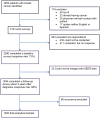Patient-reported Quality of Life and Satisfaction With Cosmetic Outcomes After Breast Conservation and Mastectomy With and Without Reconstruction: Results of a Survey of Breast Cancer Survivors
- PMID: 25654742
- PMCID: PMC4512928
- DOI: 10.1097/SLA.0000000000000908
Patient-reported Quality of Life and Satisfaction With Cosmetic Outcomes After Breast Conservation and Mastectomy With and Without Reconstruction: Results of a Survey of Breast Cancer Survivors
Abstract
Objective: Although breast conservation is therapeutically equivalent to mastectomy for most patients with early-stage breast cancer, an increasing number of patients are pursuing mastectomy, which may be followed by breast reconstruction. We sought to evaluate long-term quality of life and cosmetic outcomes after different locoregional management approaches, as perceived by patients themselves.
Methods: We surveyed women with a diagnosis of nonmetastatic breast cancer from 2005 to 2007, as reported to the Los Angeles and Detroit population-based Surveillance, Epidemiology, and End Results registries. We received responses from 2290 women approximately 9 months after diagnosis (73% response rate) and from 1536 of these 4 years later. We evaluated quality of life and patterns and correlates of satisfaction with cosmetic outcomes overall and, more specifically, within the subgroup undergoing mastectomy with reconstruction, using multivariable linear regression.
Results: Of the 1450 patients who responded to both surveys and experienced no recurrence, 963 underwent breast-conserving surgery, 263 mastectomy without reconstruction, and 222 mastectomy with reconstruction. Cosmetic satisfaction was similar between those receiving breast conservation therapy and those receiving mastectomy with reconstruction. Among patients receiving mastectomy with reconstruction, reconstruction type and radiation receipt were associated with satisfaction (P < 0.001), with an adjusted scaled satisfaction score of 4.7 for patients receiving autologous reconstruction without radiation, 4.4 for patients receiving autologous reconstruction and radiation therapy, 4.1 for patients receiving implant reconstruction without radiation therapy, and 2.8 for patients receiving implant reconstruction and radiation therapy.
Conclusions: Patient-reported cosmetic satisfaction was similar after breast conservation and after mastectomy with reconstruction. In patients undergoing postmastectomy radiation, the use of autologous reconstruction may mitigate the deleterious impact of radiation on cosmetic outcomes.
Figures



References
-
- Early Breast Cancer Trialists' Collaborative Group. Effects of radiotherapy and surgery in early breast cancer: An overview of the randomized trials. N Engl J Med. 1995;333:1444–1455. - PubMed
-
- McGuire KP, Santillan AA, Kaur P, et al. Are mastectomies on the rise? A 13-year trend analysis of the selection of mastectomy versus breast conservation therapy in 5865 patients. Ann Surg Oncol. 2009;16:2682–2690. - PubMed
-
- Tuttle TM, Habermann EB, Grund EH, et al. Increasing use of contralateral prophylactic mastectomy for breast cancer patients: a trend toward more aggressive surgical treatment. J Clin Oncol. 2007;25:5203–5209. - PubMed
Publication types
MeSH terms
Grants and funding
- R01 CA088370/CA/NCI NIH HHS/United States
- N01-PC-35139/PC/NCI NIH HHS/United States
- K05 CA111340/CA/NCI NIH HHS/United States
- N01 PC035139/CA/NCI NIH HHS/United States
- P30 CA008748/CA/NCI NIH HHS/United States
- U58 DP000807/DP/NCCDPHP CDC HHS/United States
- N01 PC054404/CA/NCI NIH HHS/United States
- N01 PC035145/CA/NCI NIH HHS/United States
- N01-PC-54404/PC/NCI NIH HHS/United States
- K05CA111340/CA/NCI NIH HHS/United States
- N01-PC-35145/PC/NCI NIH HHS/United States
- R01 CA109696/CA/NCI NIH HHS/United States
- 1U58DP00807-01/DP/NCCDPHP CDC HHS/United States
LinkOut - more resources
Full Text Sources
Medical

